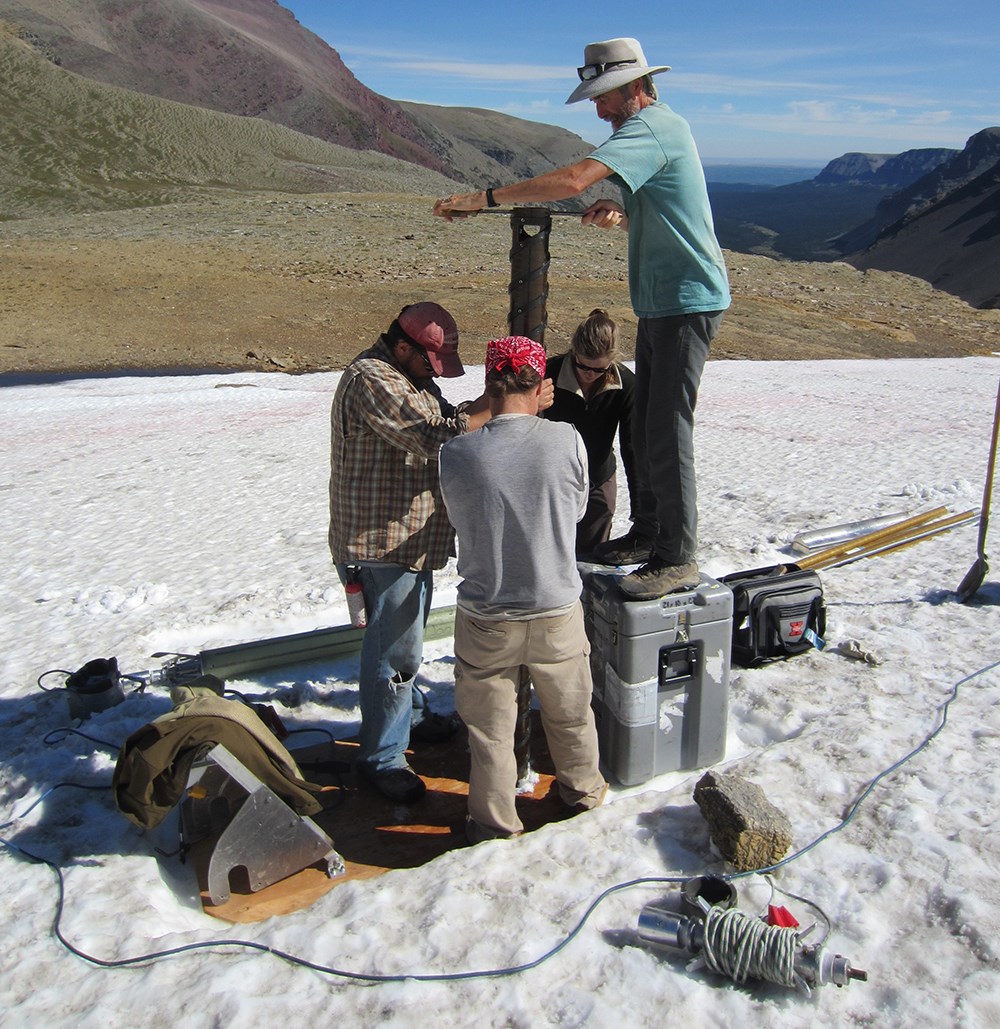Last updated: December 4, 2024
Article
Ice Patch Archeology Resource Brief
Background Information

NPS
Threats
Ice patch melt is an issue with both ecological and cultural implications. The impending loss of these ice patches will uncover ancient plant and animal remains that could tell us about past climates, as well as valuable Native American artifacts from the region’s tribes. The ice patches have kept these otherwise perishable objects frozen in time, but when the ice melts they will be exposed to the elements for the first time in centuries. If these fragile objects are not swiftly retrieved by archeologists, they could rapidly deteriorate. Other threats include animal disturbance and illegal human collection. Because artifacts are very fragile and their locations are crucial to their scientific value, it is important for visitors not to touch discovered artifacts, and to report discoveries to a park employee.
Ice patches develop at high elevations when snow and ice accumulate to levels that do not completely melt in the summer. Over years, the patches become stable and the snow turns into low-density ice. Items deposited on an ice patch by wind, animals, or humans can be frozen for centuries. Unlike glaciers, ice patches do not move at all, so encased objects remain in the same spot. Researchers studying ice patches identify and document artifacts and organic materials left behind as the ice melts. Such finds can include animal bones and scat, leaves deposited by wind, fragments of ancient wood, and lost Native American artifacts.
Unlike other archeological sites, ice patches can bring more recent objects to the same level as older ones by intermittently melting. Because of this, in a single summer a melting ice patch can release artifacts that originated centuries apart. Recovered artifacts and organic materials help to illustrate the climate and human use at the ice patch in previous times. Studying ice patches and their contents is a truly interdisciplinary pursuit, involving climate science, archeology, paleoecology, ethnography, and traditional tribal knowledge. Ancient organic matter reveals the makeup of vanished ecosystems, while human artifacts help shed light on how people interacted with the land.
Native American hunters knew that big game frequented these ice patches for refuge from heat and insects, and that ice patches were dependable hunting spots. Objects found at archeological sites throughout North America include spear points, arrow shafts, and leather leggings.
Status and Trends
From 2009-2013, a collaborative research team investigated 46 of Glacier National Park’s ice patches. The Glacier National Park Ice Patch Project’s purpose was to document ice patch melting, collect remains of ancient plants and animals, and to protect Native American cultural artifacts associated with hunting and travel in Glacier’s high-elevation regions.
Ice patches in Glacier National Park were dated by taking ice core samples. Results indicate that ice at the bottom of the patches could be over 6,000 years old. This means that the deepest parts of an ice patch have been frozen for millennia, and may soon melt completely for the first time since their initial formation.
During their investigation of Glacier National Park’s ice patches, the research team did not locate any human artifacts. The team was only able to investigate a small percentage of the park’s ice patches, and the existence of human artifacts in other ice patches is still likely. The researchers did, however, find paleoecological materials— ancient wood fragments, leaves, and feces—that ranged from 5,300 years-old to 160 years-old, according to radiocarbon dating. Some of the wood fragments collected were yew, a species no longer found in Glacier’s high country, suggesting that perhaps this species once existed at higher elevations when the climate was warmer. The research team also found the first confirmed evidence of bison in the high mountains of the park.
Glacier National Park is well known for its melting glaciers. Increasing temperatures have reduced the 150 estimated glaciers in 1850 to just 25 today. Ice patches are melting too; current estimates predict that eventually all perennial ice patches will be lost as annual temperatures increase. As the ice patches melt, more objects will be uncovered, making continued monitoring increasingly important.

NPS
Management Strategy
Of the Glacier Ice Patch Project’s successes, perhaps the longest lasting will be the establishment of field and laboratory protocols for recovery, handling, analysis, and documentation of Native American artifacts. A blend of science and tribal heritage values, these protocols were developed in close consultation with tribal partners and are now used for all discovery situations in Glacier National Park. In recognition of the robust collaboration between the National Park Service and tribal and university partners, the Department of Interior awarded the Glacier Ice Patch Project the 2012 Partners in Conservation Award.
In order to educate the public on ice patch archeology, researchers and Glacier National Park staff are developing interpretive materials, including a website, in coordination with the Confederated Salish and Kootenai Tribes and the Blackfeet Nation. As funding permits, the park will continue to target ice patches for archeological survey, particularly during high melt years.
Resources for More Information
Glacier National Park Staff
- Sierra Mandelko, Cultural Resources Specialist / Archeologist
- Tara Carolin, Director, Crown of the Continent Research Learning Center
Documents and web sites
- Glacier Ice Patch Archeology and Paleoecology Project –www.glaciericepatch.org
- Craig M. Lee and Others. 2014. Ice Patch Archaeology in Western North America. The Archaeological Record. 14(2): pp. 15-19. www.saa.org/Portals/0/SAA/Publications/thesaaarchrec/March_2014.pdf
- National Park Service Archeology Program feature – www.nps.gov/archeology/sites/npsites/glacierIcePatch
The Crown of the Continent Research Learning Center
Phone: 406-888-5827; Email: melissa_sladek@nps.gov
Website: www.nps.gov/rlc/crown
Downloadable pdf
Ice Patch Archeology Resource Brief (191 KB)
